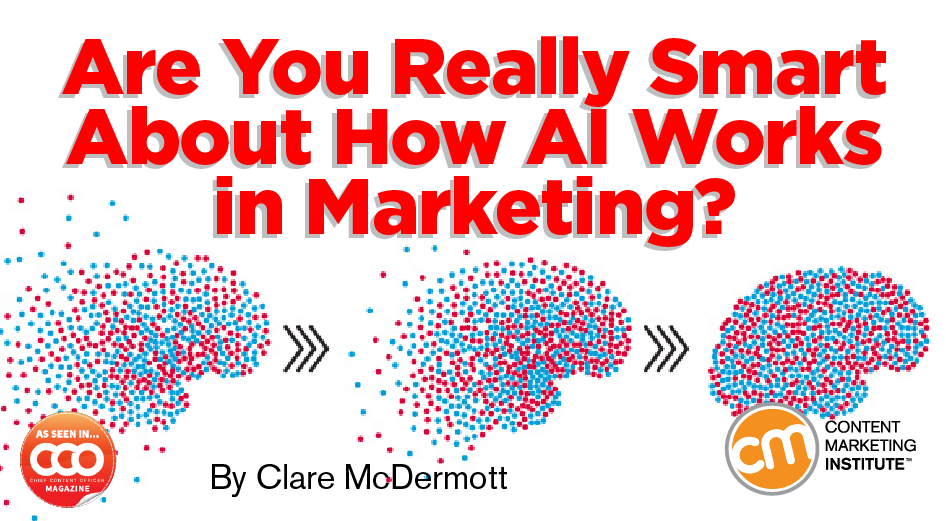Salesforce, which reports one in two marketers is using AI, or BrightEdge, which puts the number at one in 25? Using AI for personalization Marketers have long practiced personalization in content marketing, developing over time more sophisticated ways of personalizing the customer journey – whether through marketing automation and progressive profiling or using programmatic advertising to support our content path. The idea is that as we learn more about our customer or prospect and fill in information about that person’s needs, budgets, and interests, we can create unique, personalized experiences that educate and delight the person. Companies far and wide are racing to launch Alexa Skills – both to inform and delight customers as well as to test out the channel’s promise. Entertainment Content-rich brands are delivering entertainment and information via Alexa Skills. Real-time news Media companies have been among the first to offer content snippets via Alexa Skills. Beauty brand Wunder2 was the first in its segment to launch an Amazon Alexa Skill. Once upon a time, marketers would ask, “What’s the best time of day to send out our email newsletter?” Through trial and error, marketers discovered that certain days and times yielded higher open rates on average. AI, however, allows marketers to send emails based on the open histories of individual users (or people like him/her in the absence of better data). Not all content generated by marketing needs to be highly creative and witty, after all.

In its widely talked about State of Marketing Report, Salesforce reports that just over half (51%) of marketers are using AI in one form or another, while another quarter plan to test it over the next two years.
A smaller study of over 500 search, content, and digital marketers by BrightEdge found that just 4% have implemented AI (that’s not a typo).
Who’s right? Salesforce, which reports one in two marketers is using AI, or BrightEdge, which puts the number at one in 25?
The answer may be “neither.” That’s because many marketers (and business leaders as a whole) are confused about which technologies are genuinely AI-powered and which simply rely on advanced algorithms and analytics.
As Luis Perez-Breva, head of MIT’s Innovation Teams Program and research scientist at MIT School of Engineering, explains, “Most of what the retail industry refers to as artificial intelligence isn’t AI.” He says many “confuse analyzing large amounts of data and profiling customers for artificial intelligence. Throwing data at machines doesn’t make machines (or anyone) smarter.”
Rather, AI’s promise is what is often called relevance at scale. It’s the ability of machines to crunch massive datasets and data lakes – structured and unstructured data – and optimize decision-making in a way that algorithm-enabled humans cannot achieve. Perhaps most importantly, in an AI-enabled system the machine learns and improves without human input.
Rather than ask, “How many marketers are using AI?,” the more apt question may be, “What are you doing with it?” Let’s examine some of the ways companies are using AI-led initiatives to make the most of AI’s promise.
Using AI for personalization
Marketers have long practiced personalization in content marketing, developing over time more sophisticated ways of personalizing the customer journey – whether through marketing automation and progressive profiling or using programmatic advertising to support our content path. The idea is that as we learn more about our customer or prospect and fill in information about that person’s needs, budgets, and interests, we can create unique, personalized experiences that educate and delight the person.
Now we are entering the era of hyper-personalization: the ability to personalize not just by persona, profile, or the trail of breadcrumbs people leave on your site, but by a massive set of user details and signals, analyzed and made actionable by machines.
The retail industry is the most talked about application of AI-led personalization, but most examples you read about don’t really fit the definition of AI … they’re just really good personalization.
The examples that seem to cross over – from algorithm-driven personalization to AI-driven personalization – are those in which the AI sifts through data from multiple channels and sources, learning which signals matter in which circumstances and evolving its approach over time. The key variables that influence how one customer interacts with your brand may be completely different from the variables that define another, multiplied millions of times across each person, each channel, and each step of the process – and changing constantly.
Using AI for voice-searchable entertainment and education
A less common but exciting application for AI-enriched content? Virtual assistants. Alexa (Amazon) offers developers the chance to build “skills” on its platform. Alexa Skills help customers answer questions, gather information, and even control internet-enabled devices and appliances. (To be fair, there’s disagreement about whether Alexa is an AI technology or just an advanced natural language technology – another nod to the problem of assessing AI adoption.)
Companies far and wide are racing to launch Alexa Skills – both to inform and delight customers as well as to test out the channel’s promise.

COMMENTS